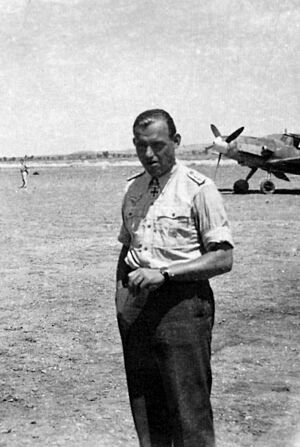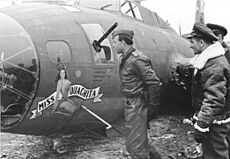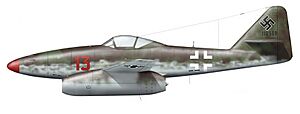Heinrich Bär facts for kids
Quick facts for kids
Heinz Bär
|
|
|---|---|
 |
|
| Birth name | Oskar-Heinrich Bär |
| Nickname(s) | Pritzl |
| Born | 25 May 1913 Sommerfeld, Kingdom of Prussia, German Empire |
| Died | 28 April 1957 (aged 43) Braunschweig, Lower Saxony, West Germany |
| Allegiance | |
| Service/ |
|
| Years of service | 1934–45 |
| Rank | Lieutenant Colonel (Oberstleutnant) |
| Unit | JG 51, JG 77, JGr Süd, JG 1, JG 3, EJG 2 and JV 44 |
| Commands held | 12./JG 51, I./JG 77, JGr Süd, II./JG 1, JG 3, III./EJG 2 and JV 44 |
| Battles/wars |
See battles
|
| Awards | Knight's Cross of the Iron Cross with Oak Leaves and Swords |
| Other work | Test pilot |
Oscar-Heinrich "Pritzl" Bär (born May 25, 1913 – died April 28, 1957) was a German Luftwaffe pilot. He was known as a "flying ace" during World War II in Europe. Bär flew over 1,000 combat missions. He fought in the Western, Eastern, and Mediterranean parts of the war. He survived being shot down 18 times. Records show he was credited with shooting down 208 enemy aircraft. Sixteen of these victories were in a Messerschmitt Me 262 jet fighter. Some sources even credit him with up to 222 aerial victories.
Bär was from Saxony, Germany. He joined the German army in 1934 and moved to the Luftwaffe (air force) in 1935. He started as a mechanic and then became a pilot for transport planes. Later, he was trained to fly fighter planes. He achieved his first aerial victory in September 1939. By the end of the Battle of Britain, he had 17 victories. He was then sent to the Eastern Front for Operation Barbarossa. There, he quickly gained more victories. This earned him the Knight's Cross of the Iron Cross with Oak Leaves and Swords in February 1942 for 90 aerial victories.
During the rest of World War II, Bär was credited with 130 more aerial victories. This achievement would normally have earned him the special Knight's Cross of the Iron Cross with Oak Leaves, Swords and Diamonds. After the war, Bär continued his career as a pilot. He died in a flying accident on April 28, 1957, near Braunschweig.
Contents
Early Life and Dreams
Bär was born on May 25, 1913, in Sommerfeld, near Leipzig. His parents were farmers. In 1916, his father died in World War I. Bär went to school in Sommerfeld. He first planned to take over the family farm. He also attended an agriculture school.
When he was 15, he became a glider pilot. He joined a glider club. Bär then wanted to become a forester. He was interested in wildlife and forests. But then he saw a Junkers transport aircraft. This changed his mind. He decided he wanted to be an aviator. As a teenager, he hoped to become an airline pilot. He got the nickname Pritzl because he loved Pritzl candy bars.
The Great Depression made it hard for Bär to get a civil pilot license. In 1934, he joined the German army as a mechanic. The next year, he moved to the Luftwaffe. A few months later, he was accepted for pilot training. He learned to fly transport aircraft. From 1937 to 1938, Bär went to several flight schools. He earned his advanced pilot's certificate. This showed he could fly multi-engine aircraft.
He then joined Jagdgeschwader 135 (JG 135) in September 1938. He usually flew the Junkers Ju 86. His Squadron Leader, Douglas Pitcairn, noticed Bär's talent. He tried to convince Bär to become a fighter pilot. Bär first said no. But after he did some illegal aerobatics in the Ju 86, he agreed. He then became a fighter pilot.
World War II: A Pilot's Journey
Bär was stationed near the French border. He achieved his first victory on September 25, 1939. It was a Curtiss P-36 Hawk. This happened during the "Phoney War" air skirmishes. He received the Iron Cross 2nd Class for this. During the Battle of France, he claimed two more victories. He added 10 more during the Battle of Britain. He was awarded the Iron Cross 1st Class on July 6, 1940.
During this time, he had several emergency landings. His aircraft were often badly damaged. On September 2, 1940, a Spitfire shot him down over the English Channel. Bär had to report to Hermann Göring. When Göring asked what he was thinking in the water, Bär famously replied, "Your speech, Herr Reichsmarschall, in which you said that England is no longer an island!" This showed his bold personality. His directness often caused trouble with Göring. In early 1941, he claimed four more victories against the Royal Air Force (RAF). This brought his total to 17.
Fighting on the Eastern Front
In June 1941, Bär's unit, JG 51, moved east. They took part in Operation Barbarossa. On June 22, Bär and his wingman were escorting a damaged German bomber. They met 18 Soviet bombers. The German pilots attacked. Bär claimed two victories. They noticed the Soviet planes caught fire easily. More German planes arrived and claimed six more. None of the 18 Soviet bombers returned. Bär had achieved his 19th and 20th victories.
JG 51 was part of the German air force in the central Eastern Front. Bär claimed five aerial victories on June 30, 1941. This brought his total to 22. On that day, JG 51 reached 1,000 total victories. This was the first unit to do so. Within two weeks, Bär's total rose to 27. This earned him the Knight's Cross of the Iron Cross on July 2. He was also promoted to Oberleutnant on August 1, 1941.
Leading a Squadron
On July 20, 1941, Bär became a Staffelkapitän (Squadron Leader) of 12. Staffel in JG 51. He claimed a Petlyakov Pe-2 on July 23. On August 9, he claimed a Soviet bomber. Bär had achieved his 55th victory.
"A very good pilot in any of these aircraft was tough to handle, and if he had the tactical advantage, he had a good chance to win the fight. You see from my own eighteen experiences as someone else's victory, that they often did win."
On August 14, he received the Knight's Cross of the Iron Cross with Oak Leaves for reaching 60 victories. On August 30, he shot down six Soviet aircraft in one day. This made him an "ace-in-a-day." The next day, an Ilyushin Il-2 shot Bär down. He was about 50 km (31 mi) behind Soviet lines. He was injured while bailing out. Bär hid from Soviet patrols. He turned his jacket inside out and took off his flying boots. He wanted to look like a Russian farmer. He hid his Knight's Cross and Oak Leaves. Bär eventually reached German lines. But his injuries worsened. He spent two months in the hospital.
Bär was promoted to Hauptmann in late 1941. He became Squadron Leader of 12./JG 51 in early 1942. By late 1941, Bär had 80 victories. This placed him among the top pilots. In January, he became Gruppenkommandeur (Group Commander). He received the Knight's Cross of the Iron Cross with Oak Leaves and Swords on February 16. His total victories rose to 90. This was mentioned in the daily Wehrmachtbericht (German army report).
On May 11, Bär moved to command I. Gruppe of Jagdgeschwader 77 (JG 77). JG 77 supported fighting in the Crimean Campaign. Bär and another ace, Gordon Gollob, led JG 77. They controlled the air space over Kerch-Taman. Bär shot down three LaGG-3s. This raised his total to 93. Gollob and Bär had a strong rivalry. Gollob was very disciplined and pro-Nazi. Bär was more anti-authority. On May 19, 1942, Bär claimed five more aerial victories. His total was now 103. He was the 9th Luftwaffe pilot to reach 100 victories. This earned him a second mention in the Wehrmachtbericht.
Battles in the Mediterranean
In June 1942, JG 77 moved to the Mediterranean theater. They fought in the air battles over Malta. Then they moved to Tunisia for the North African campaign. On October 13, 1942, he claimed three Spitfire fighters. I./JG 77 soon moved to North Africa. They took part in the Tunisian Campaign.
On January 25, 1943, Bär claimed two Curtiss P-40 fighters. This brought his total to 149 aerial victories. After his 149th victory, General Hans-Jürgen von Arnim suggested him for the Knight's Cross of the Iron Cross with Oak Leaves, Swords and Diamonds. But Hermann Göring denied this request. The reason is not fully clear. But it is thought that Göring did not like Bär's independent nature. He also disliked Bär's strong accent. On January 27, 1943, Bär passed 150 aerial victories.
On February 4, Bär led his group against Boeing B-17 Flying Fortress bombers. These were escorted by Lockheed P-38 Lightning fighters. Bär claimed one B-17. On February 15, Bär claimed two USAAF Spitfires. On February 26, he claimed five more planes.
"He was honest through and through. Whatever he told you was the truth. He never tried to cover things up as some pilots did."
Bär and his unit operated from Fatnassa, Tunisia, in early March 1943. On March 1 or 2, Bär claimed a Spitfire. He then met Adolf Galland, another famous pilot. They became good friends. On March 6, Bär shot down two Spitfires.
Over North Africa and the Mediterranean, Bär increased his total to 179 victories. But the Allies had more and more planes. Bär became tired and stressed. After arguments with Hermann Göring and his new commander, Bär was sent to France in mid-1943. He was temporarily assigned to a training unit, Jagdgruppe Süd. On August 6, Bär was officially removed from command.
Defending Germany
Bär's flying skills were too good to ignore. So, he was transferred to II./Jagdgeschwader 1 (JG 1) on January 21, 1944. He was an ordinary pilot there. The Wing Commander, Colonel Walter Oesau, reminded Bär that he had promised Göring that Bär would not be given any command roles. Bär joked about it. But he told others that in the air, he was the "Kommodore of his own crate." On February 19, Bär became commander of 6./JG 1.
On March 15, 1944, Bär, now a Major, was given command of II./JG 1. This was after the death of another commander. JG 1 was defending Germany. They flew Focke-Wulf Fw 190A-7 fighters. The group's morale improved a lot with Bär in command. He was seen as the unofficial leader. On April 11, 1944, Bär achieved his 199th victory over a B-17. His 200th victory was a Consolidated B-24 Liberator on April 22. He and his wingman, Leo Schuhmacher, quickly took off to intercept a damaged B-24. The bomber's gunners had already bailed out. This made it an easy victory. Bär returned to cheers from his men. This 200th victory earned Bär his third and final mention in the Wehrmachtbericht.
After Oesau's death on May 11, 1944, Bär became acting Wing Commander of JG 1. In June, he was appointed Wing Commander of Jagdgeschwader 3 (JG 3). By the end of 1944, Bär's score reached 203.
Bär claimed his 204th and 205th victories on January 1, 1945. These were against two Hawker Typhoons during Operation Bodenplatte. This was a large German air attack on Allied airfields.
Flying Jet Fighters
On February 14, Bär was transferred to command a jet fighter training unit. This was III. Gruppe of Ergänzungs-Jagdgeschwader 2 (EJG 2). In March, the unit received the Messerschmitt Me 262 jet fighter. They were sent into battle. Bär shot down 13 Allied aircraft, including heavy bombers like the B-17 and B-24.
On April 23, Bär moved to the special jet unit Jagdverband 44 (JV 44). This unit was led by Adolf Galland. The next day, Bär briefed the JV 44 pilots. He told them how to approach incoming American planes. On April 26, he took command of the unit after Galland was wounded. Bär flew his first mission with JV 44 on April 27, 1945. He flew a special Me 262 with six cannons. He claimed one aerial victory. When not flying, Bär spent his time quickly training new pilots. With JV 44, he achieved his final four aerial victories on April 28. These were three P-47s and one Mosquito. This brought his total to 220. He had achieved 16 victories in the Me 262. This made him the second most successful jet pilot of the war. He finished the war as a Lieutenant Colonel (Oberstleutnant).
In the final days of the war, Galland tried to surrender JV 44 to American forces. But another general ordered JV 44 to move to Prague and keep fighting. Bär, loyal to Galland, tried to ignore the order. There was a heated argument between Bär and other generals. Bär said he would only follow Galland's orders. This act of disobedience could have led to him being shot.
In the early morning of May 4, 1945, Bär gathered the JV 44 pilots. He ordered the remaining Me 262s to be destroyed. Then, he went into captivity. He was questioned by US intelligence officers.
Life After the War
After World War II, Bär did not return to his hometown. He settled in Braunschweig. He continued his career in aviation. He held a lead position for motor-powered flight with the Deutscher Aero Club. He also worked as a consultant and test pilot. He tested aircraft before they were sold. On April 28, 1957, Bär was doing a routine flight-check in a light aircraft. He put the plane into a flat spin, which was the final test. The aircraft spun down to 50 meters (164 ft). He could not regain control. Bär died in the crash at Braunschweig-Waggum.
Summary of Career
Bär, whose call sign was "Bussard 1", flew over 1,000 combat missions. His 220 confirmed aerial victories place him eighth on the overall list of aces. He claimed 124 victories over Western-flown aircraft. This is second only to Hans-Joachim Marseille. Bär achieved four victories during the Battle of France. He had 13 during the Battle of Britain. He also claimed 61 over Libya and Tunisia. On the Eastern Front, he claimed 96 aerial victories. At least 75 of his victories were against British and American aircraft over Europe. Sixteen of these were while flying the Me 262 jet fighter. Among these 75 victories were 21 US heavy bombers and one Mosquito. Bär crash-landed or bailed out 18 times. He was wounded three times in combat.
Aerial Victory Claims
According to historian David T. Zabecki, Bär was credited with 221 aerial victories. Other sources list him with 221 or 222 victories. According to Spick, Morgan, and Weal, Bär was credited with 220 aerial victories. Researchers Mathews and Foreman found records for 208 aerial victory claims. They also found 20 more unconfirmed claims. This includes 95 victories on the Eastern Front and 113 on the Western Front. This also includes 14 four-engined bombers and 15 victories with the Me 262 jet fighter.
Awards and Recognition
- German Cross in Gold on May 27, 1942
- Combined Pilots-Observation Badge
- Honor Goblet of the Luftwaffe on June 8, 1942
- Iron Cross (1939)
- 2nd Class (September 29, 1939)
- 1st Class (July 6, 1940)
- Knight's Cross of the Iron Cross with Oak Leaves and Swords
- Knight's Cross on July 2, 1941
- 31st Oak Leaves on August 14, 1941
- 7th Swords on February 16, 1942
- Three mentions in the Wehrmachtbericht (February 12, 1942, May 20, 1942, April 24, 1944)
Bär was recommended three times for the Knight's Cross of the Iron Cross with Oak Leaves, Swords and Diamonds. All three requests were denied by Hermann Göring. Bär shot down 130 more enemy aircraft after he received the Swords.
Ranks Held
| April 4, 1934: | Gefreiter (Private First Class) |
| October 1, 1939: | Feldwebel (Sergeant) |
| August 1, 1940: | Leutnant (Second Lieutenant) |
| August 14, 1941: | Oberleutnant (First Lieutenant) |
| December 1, 1941: | Hauptmann (Captain) |
| March 1, 1943: | Major (Major) |
| January 1, 1945: | Oberstleutnant (Lieutenant Colonel) |




